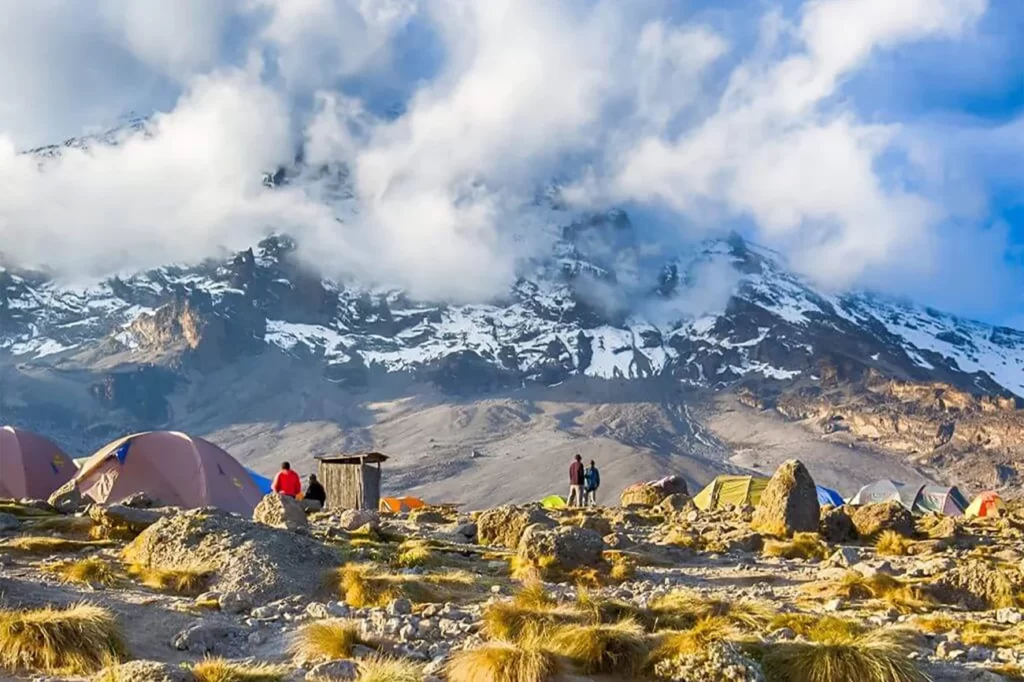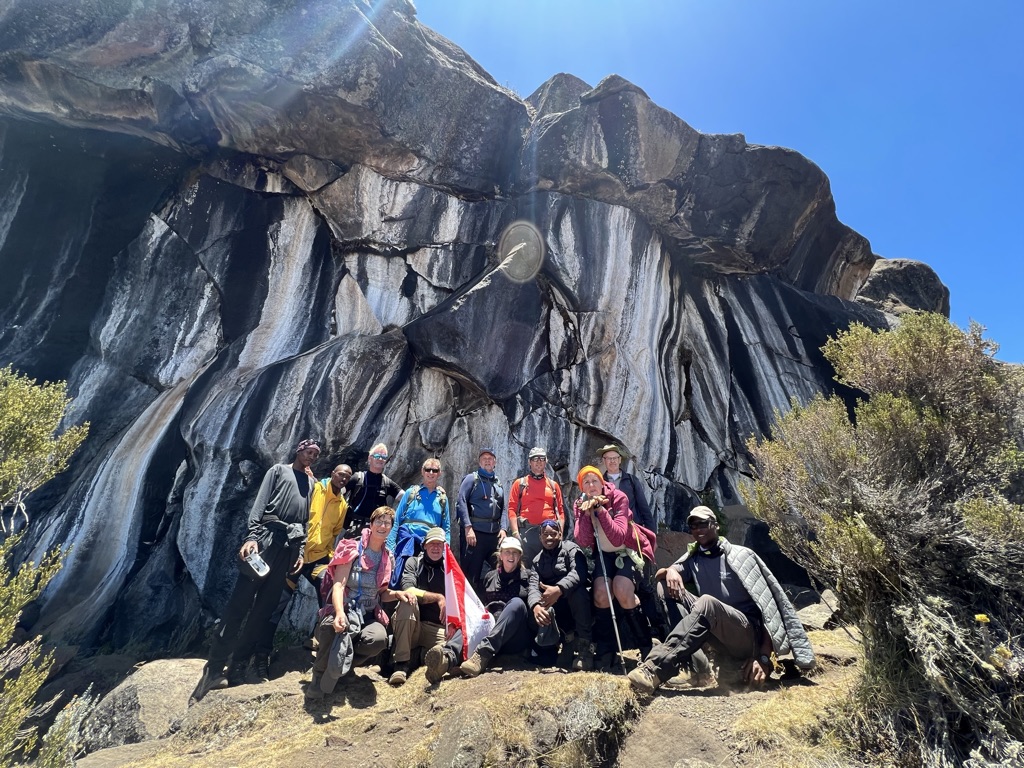Kilimanjaro towers at 5,895 m/19,340 ft above sea level. It is the highest free standing mountain in the world and the “Roof of Africa”.
Mt Kilimanjaro is one of the most popular travel attractions on the continent. Over 40,000 people visit it every year. The reasons for its popularity are simple. It’s an incredibly beautiful trek where a climber doesn’t require technical climbing skills. To reach the summit, one needs only a healthy average fitness level. This is why many people begin their Seven Summits journey with Mount Kilimanjaro.
We wrote this guide to help climbers prepare for their once-in-a-lifetime Kilimanjaro adventure. All the recommendations below are the results of our 10+ years of Kilimanjaro experience. Over this time we at Esere Safaris have organized Mount Kilimanjaro hiking trips for over 20,000 people.

The Machame hiking trail, situated on Kilimanjaro’s southern slope, is renowned as the mountain’s second most popular route. It sets off from the verdant tropical rainforest, offering a captivating start amidst lush greenery. Novice climbers are often recommended to choose the seven-day itinerary along this trail, allowing for gradual acclimatization to the altitude and terrain. This extended duration enhances safety and comfort, ensuring a more enjoyable ascent for those less experienced in high-altitude trekking.![]()
Esere’s group, a notable expedition organizer, frequently opts for the Machame Route due to its combination of scenic beauty and moderate challenge. The allure of this path lies not only in its breathtaking vistas but also in the manageable difficulty level, appealing to adventurers seeking a memorable yet manageable trekking experience. With its diverse landscapes and gradual elevation gain, the Machame Route promises an adventure filled with awe-inspiring sights and achievable goals, making it a preferred choice for those embarking on their Kilimanjaro journey.
As trekkers navigate through the Machame Route, they are treated to a diverse array of landscapes, from the dense rainforest to the alpine desert. The seven-day itinerary allows ample time for trekkers to adjust to the changing altitude and terrain, reducing the risk of altitude-related illnesses. This careful pacing not only enhances safety but also allows adventurers to fully immerse themselves in the stunning surroundings, forging unforgettable memories along the way.
The Lemosho Route, commencing from Kilimanjaro’s western side, boasts a trailhead renowned for its remoteness, offering trekkers a sense of seclusion and adventure from the outset. A prominent feature along this route is the famed Shira Plateau, a sprawling expanse of highland characterized by its dramatic landscapes and panoramic views. Standing proudly within this vista is the majestic Cathedral Peak, towering at an impressive elevation of 3,962 meters (13,000 feet), marking the pinnacle of Kilimanjaro’s western slope and captivating the imagination of all who trek in its shadow.![]()
Renowned for its exceptional acclimatization opportunities, the Lemosho Route is regarded by our experts as one of the premier choices for both group and individual treks up Kilimanjaro. Its gradual ascent allows for a more gradual adjustment to the increasing altitude, reducing the risk of altitude-related ailments and ensuring a safer and more enjoyable journey for climbers. This careful pacing not only enhances the overall trekking experience but also offers ample opportunities for trekkers to appreciate the diverse flora and fauna that thrive in Kilimanjaro’s unique ecosystem.
With its combination of stunning scenery, strategic acclimatization, and sense of remoteness, the Lemosho Route stands out as one of the best options for those seeking an unforgettable Kilimanjaro adventure. Whether embarking on a group expedition or venturing solo, trekkers are drawn to the allure of this route, enticed by the promise of breathtaking vistas and the opportunity to conquer one of Africa’s most iconic peaks.
Marangu, winding its way along the Eastern slope of Kilimanjaro, stands out as the favored route among climbers. In 2023, it attracted more than 30% of those who tackled Kilimanjaro, cementing its status as the most sought-after path on the mountain. What distinguishes Marangu from the rest is its unique accommodation setup. Unlike other routes where hikers retire to tents each night, Marangu offers shared wooden huts, accommodating between four to ten individuals. This arrangement not only provides shelter but also fosters a sense of camaraderie among trekkers, especially beneficial during the rainy season when protection from the elements is paramount.![]()
Moreover, Marangu presents a distinct advantage with its unified trail for both ascent and descent. While other routes may diverge, Marangu follows the same path throughout the journey, simplifying navigation and offering a sense of familiarity to climbers. This feature streamlines logistics and reduces the likelihood of getting lost, particularly crucial in the challenging terrain of Kilimanjaro. Additionally, the shared huts contribute to this seamless experience, allowing hikers to rest and recuperate in comfort before continuing their trek.
The Marangu route’s popularity is further underscored by its practicality and convenience. With wooden huts replacing tents, climbers can enjoy a more structured accommodation experience, shielded from adverse weather conditions. This setup, combined with the continuity of the trail, renders Marangu an accessible choice for both novice and seasoned adventurers alike, promising a memorable journey up Africa’s tallest peak.
Rongai stands out as Kilimanjaro’s solitary route on the northern flank, bordering Kenya. Its distinctive appeal lies in the serene journey through a captivating forest adorned with majestic pine trees. This lesser-traveled path presents an enticing option for climbers seeking solitude and tranquility amidst nature’s splendor. With fewer crowds, trekkers can relish a more intimate experience with Kilimanjaro’s pristine wilderness, making Rongai an optimal choice for ascending Africa’s highest peak at any time of the year.![]()
The descent along the eastern Marangu route further enhances the allure of the Rongai expedition. This carefully chosen path grants hikers the privilege of beholding the awe-inspiring panoramas of eastern Kilimanjaro. As adventurers make their way down from the summit, they are greeted by breathtaking vistas that showcase the majestic beauty of the mountain in all its glory. This scenic descent serves as a fitting conclusion to the Rongai journey, offering trekkers a memorable finale to their Kilimanjaro expedition.
The combination of Rongai’s tranquil ambiance and the picturesque descent via the eastern Marangu route creates an unparalleled trekking experience. Amidst the serene pine forest and sweeping views of eastern Kilimanjaro, adventurers forge unforgettable memories that linger long after their descent. Whether seasoned climbers or first-time trekkers, those who embark on the Rongai journey are rewarded with an enriching exploration of Kilimanjaro’s northern wilderness, leaving them captivated by its beauty and grandeur.

Mount Kilimanjaro National Park is in northern Tanzania, East Africa. It is just three degrees south of the equator. While some of the most iconic panoramic shots of Mt. Kilimanjaro have been captured from the Kenyan side, all trailheads lie in Tanzania. Therefore, tourists can only climb Mt Kilimanjaro in Tanzania. The closest airport is Kilimanjaro International Airport.
Many Kilimanjaro expeditions begin in Moshi, the capital of the same region.
Late December to early March and mid-June to late October are the best times for a Kilimanjaro climb. This is when the Kilimanjaro weather is nearly ideal.
Although other months have rain, it doesn’t mean there are constant heavy showers. Typically, rains begin in the latter half of the day. This allows trekkers a significant window of clear weather every day during the rainy season. There are also days without any rain. Esere Safaris offers discounted climbs during the wet season.
Uhuru Peak, the summit of Mount Kilimanjaro, stands tall at 5,895 meters (19,341 feet). Yet, this doesn’t mean you’ll be starting your climb from the very base. Most hotels near Kilimanjaro are at an altitude of 700-1,000 meters above sea level. The trailheads begin at elevations of 1,600 meters and above.
Due to its altitude, Mt Kilimanjaro is among the few places in East Africa to see snow. The snow-capped peak of Kilimanjaro is truly a sight to behold!
We believe that after seeing it, Ernest Hemingway decided to name his famous story “The Snows of Kilimanjaro.” The title refers to the distant peak of Mount Kilimanjaro. It represents the unattainable, and the purity of idealist motives. In the story’s conclusion, the protagonist dreams of being taken to the summit of Kilimanjaro, symbolizing redemption.
The time it takes to climb Kilimanjaro depends on the route chosen. Most expeditions last 6 to 8 days. An experienced hiker with prior acclimatization usually climbs Kilimanjaro through an accelerated 5-day program. If you stay overnight in the crater, Kilimanjaro climbs can take 9 days or longer.
Among the Seven Summits, the Kilimanjaro trek is one of the shortest. For example, climbing Mount Everest takes 6-9 weeks, Denali and Aconcagua- 2-3 weeks. Kilimanjaro takes about one week only.
Climbing Kilimanjaro is subject to the regulations of the Kilimanjaro National Park. The official rules dictate that a local guide must accompany all hikers. Rangers at the park will not permit entry to anyone without a professional Kilimanjaro guide.
Also, venturing up to the Roof of Africa solo involves certain risks. During the summit night in the peak zone, one may succumb to altitude sickness or get injured. If needed, the guides will assist with evacuations and other emergencies.
Finally, climbing Kilimanjaro is more than merely a physical challenge. You’ll go on a rich cultural journey with your guides. You will learn about Kilimanjaro’s plants, animals, and history. The guides will also share vibrant stories of the communities living in its shadow.
Anyone planning to climb Kilimanjaro should keep the park entrance fees in mind. As of today, they come at $140 per day per hiker. This amount includes several types of fees:
‘Camping fees’, or ‘hut fees’ on the Marangu route. – The fees for pitching the tents or sleeping in the Marangu wooden cabins in the park.
‘Crew fees’ – there is a small charge for each crew member entering the National Park to support you on the trek.
‘Rescue fee’ – this is a sort of mandatory ‘insurance’ payment. The hikers pay it to use the Kilimanjaro rescue cars. Please keep in mind that this is not a substitute for a real insurance package.
Don’t worry about the park fees when planning your trip. Tour operators include them in the tour price and we will pay them to the park authorities on your behalf. Climbing Mount Kilimanjaro with Esere Safari you can be sure that we will take care of every detail.